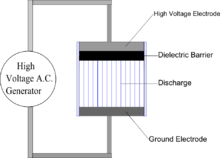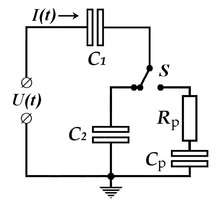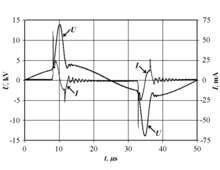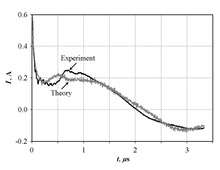Dielectric barrier discharge
Dielectric-barrier discharge (DBD) is the electrical discharge between two electrodes separated by an insulating dielectric barrier. Originally called silent (inaudible) discharge and also known as ozone production discharge[1] or partial discharge,[2] it was first reported by Ernst Werner von Siemens in 1857.[3] On right, the schematic diagram shows a typical construction of a DBD wherein one of the two electrodes is covered with a dielectric barrier material. The lines between the dielectric and the electrode are representative of the discharge filaments, which are normally visible to the naked eye. Below this, the photograph shows an atmospheric DBD discharge occurring in between two steel electrode plates, each covered with a dielectric (mica) sheet. The filaments are columns of conducting plasma, and the foot of each filament is representative of the surface accumulated charge.

Process
The process normally uses high voltage alternating current, ranging from lower RF to microwave frequencies.[4] However, other methods were developed to extend the frequency range all the way down to the DC. One method was to use a high resistivity layer to cover one of the electrodes. This is known as the resistive barrier discharge.[5] Another technique using a semiconductor layer of gallium arsenide (GaAs) to replace the dielectric layer, enables these devices to be driven by a DC voltage between 580 V and 740 V.[6]
Construction
DBD devices can be made in many configurations, typically planar, using parallel plates separated by a dielectric or cylindrical, using coaxial plates with a dielectric tube between them.[7] In a common coaxial configuration, the dielectric is shaped in the same form as common fluorescent tubing. It is filled at atmospheric pressure with either a rare gas or rare gas-halide mix, with the glass walls acting as the dielectric barrier. Due to the atmospheric pressure level, such processes require high energy levels to sustain. Common dielectric materials include glass, quartz, ceramics and polymers. The gap distance between electrodes varies considerably, from less than 0.1 mm in plasma displays, several millimetres in ozone generators and up to several centimetres in CO2 lasers.
Depending on the geometry, DBD can be generated in a volume (VDBD) or on a surface (SDBD). For VDBD the plasma is generated between two electrodes, for example between two parallel plates with a dielectric in between[8]. At SDBD the microdischarges are generated on the surface of a dielectric, which results in a more homogeneous plasma than can be achieved using the VDBD configuration [9] At SDBD the microdischarges are limited to the surface, therefore their density is higher compared to the VDBD.[10] The plasma is generated on top of the surface of an SDBD plate. To easily ignite VDBD and obtain a uniformly distributed discharge in the gap, a pre-ionization DBD can be used[11].
A particular compact and economic DBD plasma generator can be built based on the principles of the piezoelectric direct discharge. In this technique, the high voltage is generated with a piezo-transformer, the secondary circuit of which acts also as the high voltage electrode. Since the transformer material is a dielectric, the produced electric discharge resembles properties of the dielectric barrier discharge.[12][13]
Operation
A multitude of random arcs form in operation gap exceeding 1.5 mm between the two electrodes during discharges in gases at the atmospheric pressure .[14] As the charges collect on the surface of the dielectric, they discharge in microseconds (millionths of a second), leading to their reformation elsewhere on the surface. Similar to other electrical discharge methods, the contained plasma is sustained if the continuous energy source provides the required degree of ionization, overcoming the recombination process leading to the extinction of the discharge plasma. Such recombinations are directly proportional to the collisions between the molecules and in turn to the pressure of the gas, as explained by Paschen's Law. The discharge process causes the emission of an energetic photon, the frequency and energy of which corresponds to the type of gas used to fill the discharge gap.
I-V characteristic of DBD

The electrical diagram of the DBD device at the absence of discharge can be presented in the form shown in Fig. 1 where is capacitance of dielectric adjacent to one of two electrodes and is capacitance of the air (or gas) gap between the dielectric within the adjacent electrode footprint and the ground electrode. and are capacity and resistance modeling electric response of plasma. If a switch connects the capacitors and shown in Fig. 1 (there is no electrical breakdown), the voltage generator is connected to a circuit comprising two capacitors and connected in a series circuit. A capacitance of this circuit can be expressed as
, (1)
and the electric current through this circuit can be expressed in the form
, (2)

where is a generator voltage. Oscillogramsand obtained in the case of the electrical breakdown of the operating gap, switch in Fig. 1 is connected to , are presented in Fig. 2. We are going to describe, in a first order of approximation, the plasma response to voltage applied to the gap in the same way as a series circuit of two invariable components and . To proof this assumption valuability, let us express the value in the form
, (3)
where the second term on the right hand side is a drop in potential on the capacitor , and is the integration constant. The current can be expressed in terms of the voltage and values and . For this purpose, let us present the value in the form of sum
, (4)
where and represent the drops in potential on the resistor and capacitor respectively. Taking into account that the electric current through the circuit can be expressed as and consequently,
,
the equation (4) can be rewritten as the standard linear differential equation
, (5)
which solution is
, (6)
where is the integration constant. Differentiating Equation (6) with respect to and substituting the result in Equation (5), one can express the current in terms of the voltage and values and :

, (7)
where
, (8)
is drop in potential on plasma, and is the constant near-electrode drop in potential. Four parameters: , ,, and can be found by procedure of fitting of the theoretical function , calculated from the experimental value by equation (7), with the actual electric current measured in experiment. Results of the least square fitting, corresponding to some particular case, are shown in Fig. 3. For detail of the equation (7) derivation and possibilities to analyse DBD parameters, see Ref.[15] The equation (7) represents the I-V characteristic of DBD in a most general form.
Applications
Usage of generated radiation
DBDs can be used to generate optical radiation by the relaxation of excited species in the plasma. The main application here is the generation of UV-radiation. Such excimer ultraviolet lamps can produce light with short wavelengths which can be used to produce ozone in industrial scales. Ozone is still used extensively in industrial air and water treatment.[7] Early 20th-century attempts at commercial nitric acid and ammonia production used DBDs[16] as several nitrogen-oxygen compounds are generated as discharge products.[3]
Usage of the generated plasma
Since the 19th century, DBDs were known for their decomposition of different gaseous compounds, such as NH3, H2S and CO2. Other modern applications include semiconductor manufacturing, germicidal processes, polymer surface treatment, high-power CO2 lasers typically used for welding and metal cutting, pollution control and plasma displays panels, aerodynamic flow control… The relatively lower temperature of DBDs makes it an attractive method of generating plasma at atmospheric pressure.
Industry
The plasma itself is used to modify or clean (plasma cleaning) surfaces of materials (e.g. polymers, semiconductor surfaces), that can also act as dielectric barrier, or to modify gases [17] applied further to “soft” plasma cleaning and increasing adhesion of surfaces prepared for coating or gluing (flat panel display technologies).
A dielectric barrier discharge is one method of plasma treatment of textiles at atmospheric pressure and room temperature. The treatment can be used to modify the surface properties of the textile to improve wettability, improve the absorption of dyes and adhesion, and for sterilization. DBD plasma provides a dry treatment that doesn't generate waste water or require drying of the fabric after treatment. For textile treatment, a DBD system requires a few kilovolts of alternating current, at between 1 and 100 kilohertz. Voltage is applied to insulated electrodes with a millimetre-size gap through which the textile passes.[18]
An excimer lamp can be used as a powerful source of short-wavelength ultraviolet light, useful in chemical processes such as surface cleaning of semiconductor wafers.[19] The lamp relies on a dielectric barrier discharge in an atmosphere of xenon and other gases to produce the excimers.
Water treatment
An additional process when using chlorine gas for removal of bacteria and organic contaminates in drinking water supplies.[20]Treatment of public swimming baths, aquariums and fish ponds involves the use of ultraviolet radiation produced when a dielectric mixture of xenon gas and glass are used.[21][22]
Surface modification of materials
An application where DBDs can be successfully used is to modify the characteristics of a material surface. The modification can target a change in its hydrophilicity, the surface activation, the introduction of functional groups, and so on. Polymeric surfaces are easy to be processed using DBDs which, in some cases, offer a high processing area[23].
Medicine
Dielectric barrier discharges were used to generate relatively large volume diffuse plasmas at atmospheric pressure and applied to inactivate bacteria in the mid 1990s.[24]This eventually led to the development of a new field of applications, the biomedical applications of plasmas. In the field of biomedical application, three main approaches have emerged: direct therapy, surface modification, and plasma polymer deposition. Plasma polymers can control and steer biological–biomaterial interactions (i.e. adhesion, proliferation, and differentiation) or inhibition of bacteria adhesion. [25]
Aeronautics
Interest in plasma actuators as active flow control devices is growing rapidly due to their lack of mechanical parts, light weight and high response frequency.[26]
Properties
Due to their nature, these devices have the following properties:
- capacitive electric load: low Power Factor in range of 0.1 to 0.3
- high ignition voltage 1–10 kV
- huge amount of energy stored in electric field - requirement of energy recovery if DBD is not driven continuously
- voltages and currents during discharge event have major influence on discharge behaviour (filamented, homogeneous).
Operation with continuous sine waves or square waves is mostly used in high power industrial installations. Pulsed operation of DBDs may lead to higher discharge efficiencies.
Driving circuits
Drivers for this type of electric load are power HF-generators that in many cases contain a transformer for high voltage generation. They resemble the control gear used to operate compact fluorescent lamps or cold cathode fluorescent lamps. The operation mode and the topologies of circuits to operate [DBD] lamps with continuous sine or square waves are similar to those standard drivers. In these cases, the energy that is stored in the DBD's capacitance does not have to be recovered to the intermediate supply after each ignition. Instead, it stays within the circuit (oscillates between the [DBD]'s capacitance and at least one inductive component of the circuit) and only the real power, that is consumed by the lamp, has to be provided by the power supply. Differently, drivers for pulsed operation suffer from rather low power factor and in many cases must fully recover the DBD's energy. Since pulsed operation of [DBD] lamps can lead to increased lamp efficiency, international research led to suiting circuit concepts. Basic topologies are resonant flyback[27] and resonant half bridge.[28] A flexible circuit, that combines the two topologies is given in two patent applications,[29][30] and may be used to adaptively drive DBDs with varying capacitance.
An overview of different circuit concepts for the pulsed operation of DBD optical radiation sources is given in "Resonant Behaviour of Pulse Generators for the Efficient Drive of Optical Radiation Sources Based on Dielectric Barrier Discharges".[31]
References
- Matsuno, Hiromitsu, Nobuyuki Hishinuma, Kenichi Hirose, Kunio Kasagi, Fumitoshi Takemoto, Yoshinori Aiura, and TatsushiIgarashi. Dielectric barrier discharge lamp, United States Patent 5757132 (Commercial website). Freepatentsonline.com. First published 1998-05-26. Retrieved on 2007-08-05.
- Dhali, S.K.; Sardja, I. (1989). "Dielectric-barrier discharge for the removal of SO/Sub 2/ From flue gas". IEEE International Conference on Plasma Science. p. 150. doi:10.1109/PLASMA.1989.166255.
- Kogelschatz, Ulrich, Baldur Eliasson, and Walter Egli. From ozone generators to flat television screens: history and future potential of dielectric-barrier discharges. Pure Applied Chemistry, Vol. 71, No. 10, pp. 1819-1828, 1999. Retrieved on 2007-08-05.
- "Aerosol charge distributions in Dielectric Barrier Discharges" (PDF). Publication date 2009. European Aerosol Conference 2009 Karlsruhe. Archived from the original (PDF) on 19 July 2011. Retrieved 2010-12-10.
- M. Laroussi, I. Alexeff, J. P. Richardson, and F. F. Dyer " The Resistive Barrier Discharge", IEEE Trans. Plasma Sci. 30, 158 (2002)
- "Structure formation in a DC-driven "barrier" discharge stability analysis and numerical solutions" (PDF). Publication date July 15–20, 2007. ICPIG Prague, Czech Republic. Retrieved 9 December 2010.
- Kraus, Martin, Baldur Eliasson, Ulrich Kogelschatzb, and Alexander Wokauna. CO2 reforming of methane by the combination of dielectric-barrier discharges and catalysis Physical Chemistry Chemical Physics, 2001, 3, 294-300. Retrieved on 2007-08-05.
- Motrescu, I.; Ciolan, M. A.; Sugiyama, K.; Kawamura, N. & Nagatsu, M. (2018). "Use of pre-ionization electrodes to produce large-volume, densely distributed filamentary dielectric barrier discharges for materials surface processing". Plasma Sources Science & Technology. 27 (11): 115005. Bibcode:2018PSST...27k5005M. doi:10.1088/1361-6595/aae8fd.
- Gibalov, V. I. & Pietsch, G. J. (2000). "The development of dielectric barrier discharges in gas gaps and on surfaces". Journal of Physics D: Applied Physics. 33 (20): 2618–2636. Bibcode:2000JPhD...33.2618G. doi:10.1088/0022-3727/33/20/315.
- Radacsi, N.; Van der Heijden, A. E. D. M.; Stankiewicz, A. I.; ter Horst, J. H. (2013). "Cold plasma synthesis of high quality organic nanoparticles at atmospheric pressure". Journal of Nanoparticle Research. 15 (2): 1–13. Bibcode:2013JNR....15.1445R. doi:10.1007/s11051-013-1445-4.
- Motrescu, I.; Ciolan, M. A.; Sugiyama, K.; Kawamura, N. & Nagatsu, M. (2018). "Use of pre-ionization electrodes to produce large-volume, densely distributed filamentary dielectric barrier discharges for materials surface processing". Plasma Sources Science & Technology. 27 (11): 115005. Bibcode:2018PSST...27k5005M. doi:10.1088/1361-6595/aae8fd.
- M. Teschke and J. Engemann, Contrib. Plasma Phys. 49, 614 (2009)
- M. Teschke and J. Engemann, US020090122941A1, U.S. Patent application
- "Dielectric-Barrier Discharges. Principle and Applications" (PDF). ABB Corporate Research Ltd., Baden, Switzerland. 11 October 1997. Retrieved 19 January 2013.
- Evgeny V. Shun’ko and Veniamin V. Belkin (2012). "Treatment surfaces with atomic oxygen excited in dielectric barrier discharge plasma of O2 admixed to N2". AIP Advances. (2012) AIP ADVANCES. 2 (2): 022157–24. Bibcode:2012AIPA....2b2157S. doi:10.1063/1.4732120.
- Chisholm, Hugh, ed. (1911). . Encyclopædia Britannica. 16 (11th ed.). Cambridge University Press. pp. 714–716.
- Evgeny V. Shun’ko and Veniamin V. Belkin. "Cleaning properties of atomic oxygen excited to metastable state 2s[sup 2]2p[sup 4]([sup 1]S[sub 0])". Journal of Applied Physics. (2007) J. Appl. Phys. 102: 083304–1–14. Bibcode:2007JAP...102h3304S. doi:10.1063/1.2794857.
- The Textile Institute, Sustainable textiles, CRC Press, ISBN 978-1-84569-453-1 page 156
- "Dielectric". Siliconfareast.com 2001-2006. Retrieved 8 January 2011.
- "Dielectric barrier discharge system with catalytically active porous segment for improvement of water treatment" (PDF). Department of Physics, University of West Bohemia, Univerzitni 22, 306 14 Plzen, Czech Republic 2008. Retrieved 9 January 2011.
- "UV v.s Chlorine". Atguv.com 2010. Retrieved 9 January 2011.
- "Dielectric barrier discharge lamp comprising an UV-B phosphor". Freepatentsonline.com 12/21/2010. Retrieved 9 January 2011.
- Nagatsu, M.; Sugiyama, K.; Motrescu, I.; Ciolan, M. A.; Ogino, A. & Kawamura, N. (2018). "Surface modification of fluorine contained resins using an elongated parallel plate electrode type dielectric barrier discharge device". Journal of Photopolymer Science and Technology. 31 (3): 379–383. doi:10.2494/photopolymer.31.379.
- M. Laroussi, "Sterilization of contaminated matter with an atmospheric pressure plasma", IEEE Trans. Plasma Sci. 24, 1188 (1996)
- Czuba, Urszula; Quintana, Robert; De Pauw-Gillet, Marie-Claire; Bourguignon, Maxime; Moreno-Couranjou, Maryline; Alexandre, Michael; Detrembleur, Christophe; Choquet, Patrick (June 2018). "Atmospheric Plasma Deposition of Methacrylate Layers Containing Catechol/Quinone Groups: An Alternative to Polydopamine Bioconjugation for Biomedical Applications". Advanced Healthcare Materials. 7 (11): 1701059. doi:10.1002/adhm.201701059. PMID 29577666.
- Roth, J. Reece (2001). "Chapter 15.3 Atmospheric Dielectric Barrier Discharges (DBDs)". Industrial Plasma Engineering: Volume 2: Applications to Nonthermal Plasma Processing (1st ed.). CRC Press. ISBN 978-0750305440.
- El-Deib, A.; Dawson, F.; Van Eerdent, G.; Bhosle, S.; Zissis, G. (2010). "Current controlled driver for a Dielectric Barrier Discharge lamp". The 2010 International Power Electronics Conference - ECCE ASIA -. Publication date 21–24 June 2010. Power Electronics Conference (IPEC) 2010 International. pp. 2331–2338. doi:10.1109/IPEC.2010.5543677. ISBN 978-1-4244-5394-8.
- "Resonance behaviour of a pulsed electronic control gear for dielectric barrier discharges". Power Electronics, Machines and Drives (PEMD 2010), 5th IET International Conference on.
- "Patent application title: Device for Generation of Voltage Pulse Sequences In Particular for Operation of Capacitive Discharge Lamps". Publication date 2005. University of Karlsruhe. Retrieved 23 May 2011.
- "Patent application title: Adaptive Drive for Dielectric Barrier Discharge (DBD) Lamp". Publication date 2008. Briarcliff Manor, New York US. Retrieved 9 December 2010.
- "Resonant Behaviour of Pulse Generators for the Efficient Drive of Optical Radiation Sources Based on Dielectric Barrier Discharges". Publication date 10.07.2013. KIT Scientific Publishing.